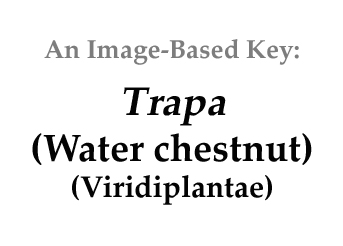|
Home / Anomalous_Items / Aquatic_Macrophytes / Floating_Leaves / Trapa |
||||
|
|
|
|||
|
|
|
|||
|
Click on images for larger format |
||||
Name derivation: |
||||
|
Derived fromLatin word for ‘thistle’. Common names: ‘water caltrop’, ‘water chestnut’, ‘buffalo nut’, ‘bat nut’, ‘devil pod’, ‘ling nut’, etc.
|
||||
Classification: |
||||
Trapa LinnaeusOrder Myrtales; Family Trapaceae
|
||||
Morphology: |
||||
|
Submerged stem up to 4.5 m long,, anchored by fine roots. Heterophylly with highly dissected submergedcd leaves along the stem, and serrate entire leaves arranged in a rosette and supported by inflated petioles for buoyance at the surface of the water. The fruit is a nut with four rigid spines each 1cm long.
|
||||
Similar genera: |
||||
|
|
||||
Habitat: |
||||
|
Global distribution with fossil record through Europe, China and N. America. The oldest known Trapa fossils are located in Alaska USA (Cretaceous), T. borealis. Intentionally reintroduced to N. America ca. 1874 for cultivation. Escapees in eastern USA are now considered invasive ‘noxious weeds’. Similarly in New South Wales Australia. Disease: Fasciolopsiasis in pigs, humans and other mammals is the result of cysts that adhere to the surface of water plants, including Trapa spp. The cysts hatch after ingestion into intestinal flukes (Fasciolopsis buski) that are up to 7.5 cm long (Kuntz and Chin-Tsong 1967).
|
||||
References: |
||||
|
Kuntz, R.E., and L. Chin-Tsong 1967. Preliminary studies on Fasciolopsis buski (Lankester 1857) (giant Asian intestinal fluke) in the United States. Transactions of the American Microscopical Society 86(2):163-166. |
||||








